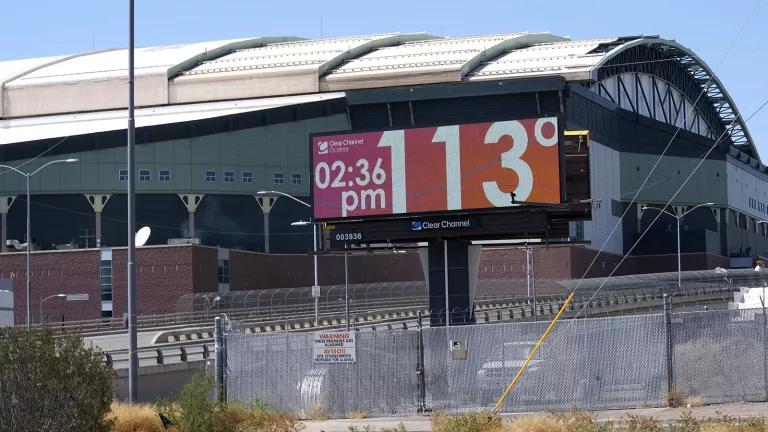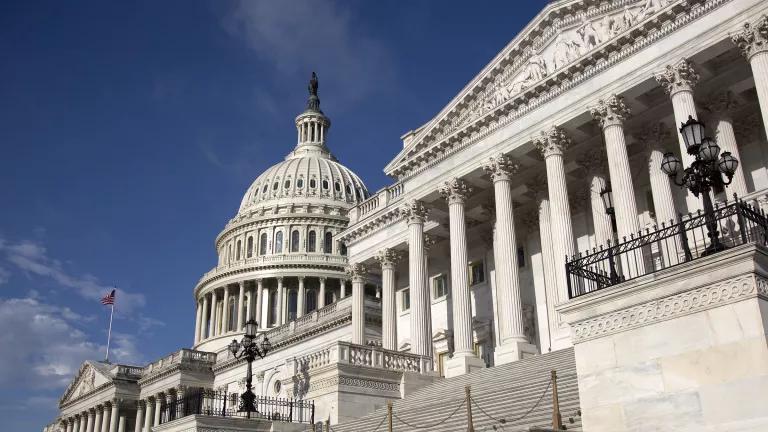This week, the Senate Committee on Homeland Security and Governmental Affairs is holding a confirmation hearing on one of the most important White House positions you’ve never heard of.
The committee will consider President Obama's nomination of Howard Shelanski to serve as Administrator of the Office of Information and Regulatory Affairs (OIRA) at the White House Office of Management and Budget (OMB). Unbeknownst to many, the OIRA administrator heads a small office within the White House OMB that acts as gatekeeper for all major federal rules.
On the eve of Mr. Shelanski’s confirmation hearing, I want to examine one federal clean air rule that exemplifies the interference, weakening influence and non-transparency exhibited by this obscure White House office. Hopefully Mr. Shelanski will work to eliminate these abuses.
It generally surprises people to hear that such an obscure office wields so much power over federal laws on health, safety, the environment, and food safety.
It may surprise you even more to hear that Cass Sunstein, the former head of this office under the Obama administration, described his role as having the authority to “say no to members of the president’s Cabinet”; to deposit “highly touted rules, beloved by regulators, onto the shit list”; to ensure that some rules “never saw the light of day”; to impose cost-benefit analysis “wherever the law allowed”; and to “transform cost-benefit analysis from an analytical tool” into a “rule of decision,” meaning that “[a]gencies could not go forward” if their rules flunked the White House’s cost-benefit test.
As Georgetown Law Professor Lisa Heinzerling has extensively and expertly documented, “the person who leads OIRA is, in the rulemaking domain, effectively the boss of members of the President’s Cabinet.”
This review structure alone raises a number of legal and constitutional questions, but equally concerning is the fact that the Obama administration “does not follow its own rules on transparency” in this White House office.
In particular, the office disregards Executive Order 12,866, a Clinton-era order whose origins date to the Reagan administration. President Obama has reaffirmed this order, which requires transparency during the White House's review of agency regulations.
Among other things, the order requires that federal agencies:
1) “Identify for the public, in a complete, clear, and simple manner, the substantive changes between the draft [agency action] submitted to OIRA for review and the action subsequently announced;” and
2) “Identify for the public those changes in the regulatory action that were made at the suggestion or recommendation of OIRA.”
As Heinzerling points out, not only do agencies and the White House fail to identify such changes, but in at least one instance she documents (p.41), the White House affirmatively instructed the agency that it could not follow the Executive Order as written and prevented the agency from making this information available.
I will examine here another example drawn from one of the Obama EPA’s clean air standards, the recently revised National Ambient Air Quality Standards (NAAQS) for nitrogen dioxide pollution. This example adds further evidence that when this White House office thinks no one is looking, agency rules—drafted by those with subject matter expertise who consider the relevant facts, science, law, and policy considerations—are overruled, reformulated, and rewritten to meet the office’s nebulous (but usually dollar-driven) objectives.
The Clean Air Act requires EPA to set national clean air standards for nitrogen dioxide pollution. This pollution increases asthma symptoms and leads to more emergency room and hospital visits, especially among sensitive populations like children, asthmatics and the elderly. Nitrogen dioxide pollution is especially prevalent near roadways, where it is emitted from cars, trucks and buses.
When EPA proposed revisions to the standards in 2009, for the first time the agency also proposed adding near-roadway air pollution monitors to the national monitoring network in order to better track the amount of nitrogen dioxide pollution near busy roads and highways. Specifically, EPA proposed (at 34,442) that:
One near-road [nitrogen dioxide] monitor be required in [population areas] with a population greater than or equal to 350,000 persons. This population threshold is proposed to provide the near-road monitoring component of the network an appropriate spatial extent across the country, given the limited availability of routine measurements in these environments.
The agency estimated that this requirement would lead to approximately 142 new monitors, covering the same number of population areas.
The total absence of air pollution monitors near highways has been a dirty little secret of the Clean Air Act for decades. Without adequate monitoring, the Clean Air Act's promise of healthy air quality for all Americans goes unfulfilled for the tens of millions of Americans who live, work and attend school near highways. (EPA estimates that over 45 million Americans live less than 300 feet from a highway.)
EPA’s proposal to require better monitoring for nitrogen dioxide near highways, albeit inadequate in its suggested scope, marked an important first step in the right direction.
However, when it came time to finalize the proposed monitoring in 2010, the final rule’s monitoring network was not nearly as robust. The final rule indicated that “the Administrator has chosen to finalize the [population area] population threshold for requiring a minimum of one near-road monitor in [Core Based Statistical Areas] with a population of 500,000 or more persons.”
A specific population area threshold of 500,000 people was nowhere mentioned in the proposed rule. Moreover, this use of a more lax population threshold would mean only 102 monitors divided among 102 population areas. The final rule determined that using the proposal's population threshold of 350,000 would have meant 143 monitors among 143 population areas, a substantially broader monitoring network and greater protections for Americans.
In describing the reasons for this shift, the agency stated that:
The basis for the selection of the proposed [population area] population level of 350,000 [in the proposal] to trigger the requirement of one near-road monitor was chosen in an attempt to provide near-road monitoring data from a diverse array of areas.... However, ... comments ... encouraged at least a reduction of the size of the required near-road network or the implementation of a relatively smaller research network.
While public “comments” may have played into EPA’s decision-making, the docket of communications between the White House and EPA tells another story. In January of 2010, one month before the nitrogen dioxide standards were finalized, an EPA employee sent an email to OIRA staff stating:
I spoke with my management. We are willing to put forward an alternative threshold for the first tier of the near-road monitoring network for you to discuss with your management at your 2:30 meeting. The alternative would use a threshold of 500,000 people, rather than 350,000 people, in determining the number of required monitors for the first tier of the near-road network. This means that areas of 500,000 or more population would be required to have one near-road monitor, for a total of 102 monitors, compared to the 143 monitors which would be required if we used the threshold of 350,000 people. The second tier of the near-road network, which requires an additional monitor in [Core Based Statistical Areas] of 2,500,000 people or more or an area which has one or more road segments with an [Annual Average Daily Traffic] over 250,000, would remain unchanged. This means that the total number of required near-road monitors would be 126, rather than 167. Please let me know if you have any questions about this alternative. We hope that if this approach works for you that we can close out this discussion today. I would appreciate it if one of you would call me after your 2:30 meeting and let me know if we have an agreement. Thanks.
A second EPA employee followed up this email with another more pointed email a few hours later: “EPA does not support the alternative threshold described in the email below.”
Reading the not-so-subtle tea leaves, one easily concludes that the 500,000 population threshold, and resulting fewer monitors, was a weaker alternative that the White House insisted on for the final rule. Unsurprisingly, the rulemaking docket does not make clear whether EPA was required to adopt the weaker monitoring network as a condition of the White House signing off on the rule; but these emails and the eventual outcome support that conclusion.
To top things off, of course there is no summary of substantive changes made to the standards, nor a record of which changes were made at the suggestion of the White House, as required by Executive Order 12,866.
It certainly seems no coincidence that the White House’s failure to follow its own transparency requirements occured at the same time that the evidence shows the White House strong-arming EPA into adopting a weaker monitoring network. But the broader truth, explained by Professor Heinzerling, is that the White House rarely seems to follow its own Executive Order's transparency practices.
Fewer air pollution monitors mean less information about the safety of the air we breathe. It means more Americans will breath unhealthy air because government officials fail to take the necessary steps to reduce air pollution near highways.
After being told what to do, EPA meekly argued in the final rule that “the percentage of the total U.S. population residing in [areas meeting the 350,000 threshold] versus [areas meeting the 500,000 threshold] differs by only approximately 5 percent of the total population.”
But 5 percent of the nation’s population is still 15 million people. These 15 million Americans presumably care whether the air is safe to breathe for themselves and their families. And those 15 million people now won’t know whether the nitrogen dioxide pollution they breathe on a daily basis surpasses levels that EPA has deemed safe.
If nothing else, this sorry chapter serves to remind us of the powerful role that an obscure White House office plays in policy decisions and law enforcement by all federal agencies. With just a political nudge, the White House can hide potentially dangerous levels of air pollution from 15 million Americans.
As Congress considers the nomination of Mr. Shelanski to serve as Administrator of this important White House office, I hope he will commit to increased transparency, respecting agency expertise, upholding the rule of law and following the Executive Orders of the President himself.




